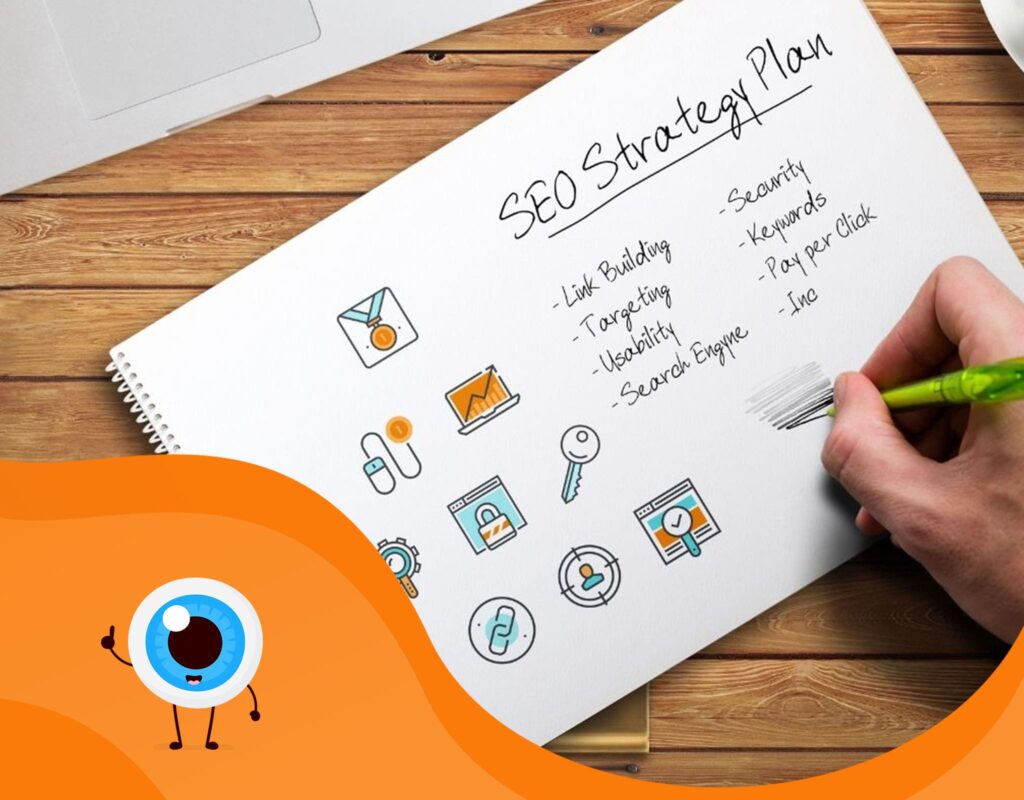How to do On-page SEO for better search engine rankings
We have created this article to help explain the importance of on-page SEO. And you understand why it is important and what a big impact it can have on your search engine rankings and traffic to your website. You will also learn how to make simple changes to your site that can have a big impact.
At SEOi we provide professional SEO services we see on a daily basis what difference good keyword research and simple on page and technical search engine optimisation can do to a businesses search results.
What is on-page SEO?
On-page SEO is a practice of optimising web pages to improve website ranking in the search engine result. And gain more targeted traffic. On-page SEO includes optimising the written content on the page, including the heading and subheading: the internal links, metadata title tags and description meta tags.
The images, meta tags and file names all play their part in on-page search engine optimisation and technical changes in the code that can help search engines find your content and understand what your content is about.
It is also possible to improve your site’s load speed by optimising images and other code improvements.. Witch search engines are focusing on user experience and improving the speed of the sites it shows in the results.
We call this technical SEO and is a vital part of on-page SEO or on-site SEO as these technical changes will affect all pages on your site. More on this later. In this article, we explain what you need to do to improve your rankings with on-page SEO.
Help Search Engines Understand You Web Pages
On-page SEO helps Google and other search engines understand what your web pages are about—helping them rank the web pages for the correct search terms.
On-page SEO plays a crucial part in ranking a website for the keywords that will bring new targeted audiences to your site and potential customers to your business. On-page SEO and technical SEO is often overlooked when creating websites and marketing strategies.
With the help of on-page SEO, the search engines will analyse the website and content to find out if your content is relevant and answers the searcher’s queries that users are searching for.
What On-page SEO Isn’t.
The other search engine optimization methods are classed as Off-page SEO. Including building backlinks to your web pages, brands mention, social media shares can, directly and indirectly, affect your site’s search engine ranks.
Once you have fully optimised your pages, with the techniques and methods we are talking about here, you can move on to working on the off-page SEO methods. Once your pages and content are fully optimised, you will find your off-page SEO efforts to bring great and faster results.
Why is On-page SEO So Important?
It is crucial to get your pages fully optimised for the search engines. This helps them find your content and work out what they are about and what keywords and phrases they should rank your content for. Trying to rank a page with poor on-page SEO with backlinks and other off-page SEO will be an uphill battle and very expensive and time-consuming.
On-page SEO has the best ROI that digital marketing has to offer. With comparatively low-cost and long-term benefits, helping the website grow and gain huge targeted traffic for many years.
Search Results Drive Revenue
Here is something that everyone needs to know. A popular search engine such as Google brings half of the website traffic, which indicates that 40% of online revenue results from search engines.
“But I believe that this is a lot higher as the business’s initial contact was probably through Google or other search engines. Then the repeat business from that customer is direct traffic from typing the web address in the browser. So repeat sales may not have been directly through Google or other search engines but should be taken into account.”
The first result that appears on the top of Google search gets approximately 35% of keyword traffic. The first page of search engine results gain approximately 91.5% of web traffic.
All businesses and website owners should be investing time or money to optimise their web pages for the search engines and their target keywords.
Basic On-Page SEO Best Practice
Content is the king that rules the page of the website and is the main reason for visitors to visit webpages. Therefore, the page’s content needs to be hyper-relevant and specific to the topic, usually product or object-based.
Ranking factors of On-page SEO
A good on-page SEO strategy isn’t enough for the site to be successful. Technical SEO is also an essential part of optimising the content to be found by the search engines. And to improve the speed of the site. It can have a massive impact on a page’s ability to rank on top of a search engine. On-page and technical factors that affect SEO rankings are:
On-page SEO
- URL structure
- Content on page
- Supporting content
- Headings and subheadings
- Title meta tag
- description meta tag
- Image alt text
- internal link structure
- site navigation structure
Technical SEO
- Site speed
- Search engine friendly code
- Robot.txt file
- Site Maps
We will break these down and explain each factor below.
1) Importance Of Optimising Your Page Content
As content and SEO go hand in hand, there is still a misconception that content is just text written on the page. The text on the page plays a crucial part in optimising your pages for the right keywords. Google and other search engines want to offer their users a rich source of information for what they are searching for. So the more relevant and good quality information you can offer them, the better. Many elements need to be considered while preparing content because it’s a significant factor in SEO. Other types of content can include images, video clips, infographics. All of these can enrich your page content.
Importance of Engaging Content
Another overlooked and crucial part of on-page SEO is making sure your content is engaging and answers the questions. Offer the information your visitors are searching for. Goole and another search engine will measure the time spent on your content when clicked on in the results. In other words, your bounce rate. They use this to make sure they are giving their users the information they are looking for.
So, people are visiting your page and then leaving quickly without reading or viewing your content. It tells the search engine that your page is not the right page to put in the search results, and your ranking will drop.
Understand you target audiences and their intent
Google algorithm is continually updating day by day to understand what searcher’s intent is when searching for keywords. So it is crucial you know your target audience and what they are looking for. Your content needs to answer their questions and offers them what they are looking for.
Do not try cheating the search engines by stuffing keywords into your content. Just write and plan your content for your target audience. And your content efforts will last the test of time.
Generally, people refer to “content” as just the text on the given page. Still, all these mentioned attributes fall under the content. Balancing all these assets helps to make webpage content solid and unique.
There are other factors too which people usually tend to underestimate while ranking the page.
One of the most critical factors that need to be considered while ranking a website on a search engine is its content, as we mentioned above. But other crucial elements are the things visible to search engines within the code, such as metadata and Text headings and subheadings. Or in HTML, they are H1, H2, H3, etc. These help search engines better understand your page and rank your site for the correct keywords and phrases.
Optimise Page Content for Search Engines and Your Target Audience
Content is always the king, so the content of the page matters for good search engine ranking. The content is what the user visits the website for and will turn the visitor into your customer. They need an answer to a question or maybe looking for extra information on a subject or a way to solve an issue. So relevant and unique content is what you should concentrate on—offering that information in an easy to absorb form.
What is good content?
Good content gives the information the search is looking for in an easy to absorb way. This is why research your keywords and phrases you will optimise your count for and then give that information that your target audience is looking for.
Content isn’t just the text written on the page. It can also be, media, images all fall under content.
Also, other factors need to be considered while creating good content. The content needs to be unique, grammatically correct, proper URL practice. Using images or video clips needs to be of good quality and give a good impression, and content needs to be formatted correctly.
How to do On-page SEO for better search engine rankings
target audience and keyword research
Researching your target audience and your keywords are essential to bringing the right target audience to your site so you can turn them into customers and revenue.
Keyword research is where all SEO Should start. Carry out keyword research to find the keywords your target audience use to search for businesses like yours. Or to search for the services, products or information you offer is key to building a profitable SEO campaign and your business and revenue online.
We offer a rank tracker tool package that has many tools to track your rankings and your competitors. You also get a keyword research tool and a competitor tool to find keywords with high monthly search terms and low competition. You can also see what keywords your competitors are ranking for and check out their content. You can also sign up for a free account on SEOi.co.uk and get a free site audit and SEO strategy free of charge, and we will do your research for you.
Optimise your URLs
Use your keywords in your page URLs if possible. This is a great way to tell Google what your page is about.
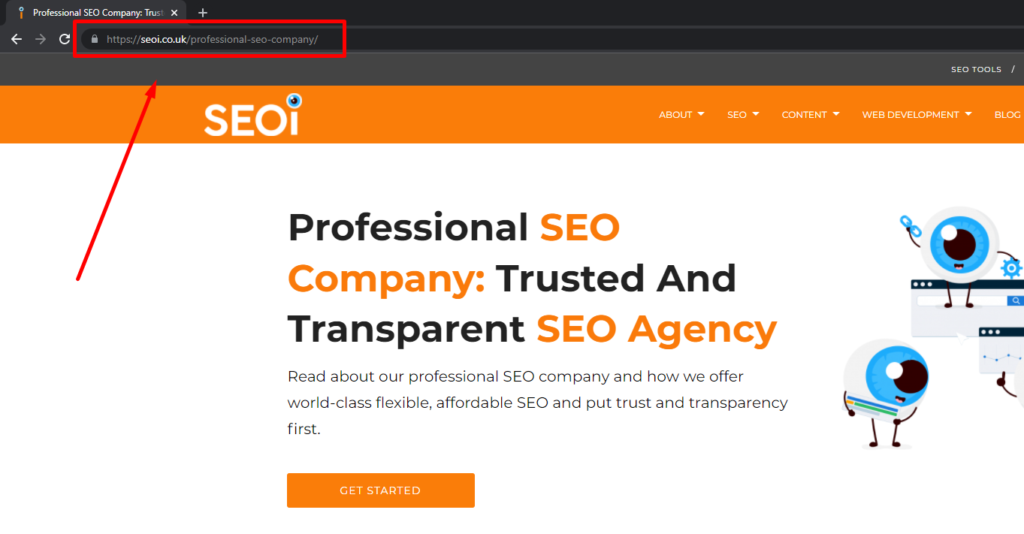
Good URL practice
Only URLs aren’t enough for good SEO. There are good and bad practices while designing the URL, which plays a vital role in maintaining the SEO of a website. Good URL practices include the category hierarchy of the website.
Example of a good website URL structure:
www.yoursite.com/clothing/leather-jackets
The following example reflects the hierarchy of info on the given page. Thus the information provided will be used by SEO to determine the relevancy of the web page.
Good URL practice helps search engines understand all of the information on your site before looking at the page content.
Write Engaging Content
Write engaging content answering your target audience questions and offering the things they are searching for. Think about the structure of the page you want to keep the visitor engaged and wanting to know more. Break the content up into bite-size peace so as not to overwhelm the visitor.
If you manage to get to the top of google results for your keywords but then the search engines sees that people are visiting your content and then quickly leaving. This will tell the search engine your content is not a good fit for this keyword.
You need to engage your audience and your content needs to persuade them to take the next action. This could be, contact you or click a link to another page. This shows google you are a good choice for this keyword.
Optimise your heading and subheadings
One of the most critical factors that need to be considered while ranking a website on a search engine is its content, as we mentioned above. But other crucial elements are the things that are visible to search engines within the code, such as metadata and Text headings and subheadings. Or in HTML, they are H1, H2, H3, etc. These help search engines better understand your page and rank your site for the correct keywords and phrases.
Your main heading (H1) should only be used once at the start of your content. You should break up your content with subheadings. This helps the search engine understand your content and what information it offers. It also makes your content easier to read and understand.
Think about the keywords and phrases they would use to search for and use them in your content and heading and subheadings. Do not cram them in. Just write naturally. Google is improving daily and can now understand search intent better than ever. So using related keywords and phrases will be noticed. Add your keyword once in the main heading and use your keyword and related keywords in the subheading, but don’t overdo it.
Optimise your images
Add original images, add your keywords and phrases to the image’s file name, and add an image alt tag explaining what that image is about. Add your keywords and related keywords again, making sure to mix it up.
Reduce the file size to your images this will speed up load speed to your site. But it is important to keep the quality of the image.
Read on to find out more on this.
Add rich content
You can add videos and infographics, and other rich media to keep your visitors engaged. Visitors love rich media and content, and so do search engines. Good quality videos, infographics and images will keep visitors engaged and improve your bounce rate as a bonus.
Optimise for conversions
Don’t forget to let your visitors know what you want them to do next. it may be to look at your product or service page, give you a call or sign up to your email list or follow you on your social channels. You want to build a relationship with your audience and be able to keep in contact with you. Always add a call to action to your page. So it’s easy to make that next move in your sales funnel.
Optimise your Metadata
One of the most critical factors must be considered while ranking a website on a search engine. Is its content, as we mentioned above. But other crucial elements are the things visible to search engines within the code, such as metadata. These help search engines better understand your pages and rank your site for the correct keywords and phrases.
Meta-data is the hidden elements only visible to search engines. Metadata is not visible on the page. It is HTML code and includes the title tag of the page and meta description.
This is the information that you see in the search results in search engine results. Metadata is another way the search engines work out what your page is about and what information your page offers.
Optimise Your Title Tags
The title tag is a snippet of code that you add to your header that tells the search engines what you want to show as your title in the search results pages.
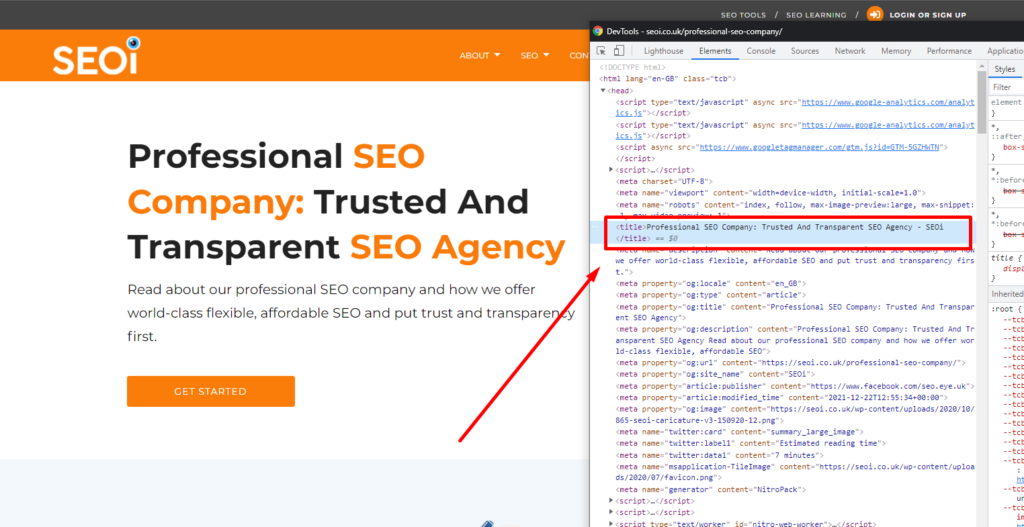
It is essential to optimise these for your chosen keywords and your target audience. Add your keywords at the beginning. Google typically displays the first 50–60 characters of a title tag. It would help if you optimised it for your target audience also. Why will they click on yours? It is a good idea to search for your keyword. And see what your competition is using and write your title tag to stand out. But remember to use your keywords.
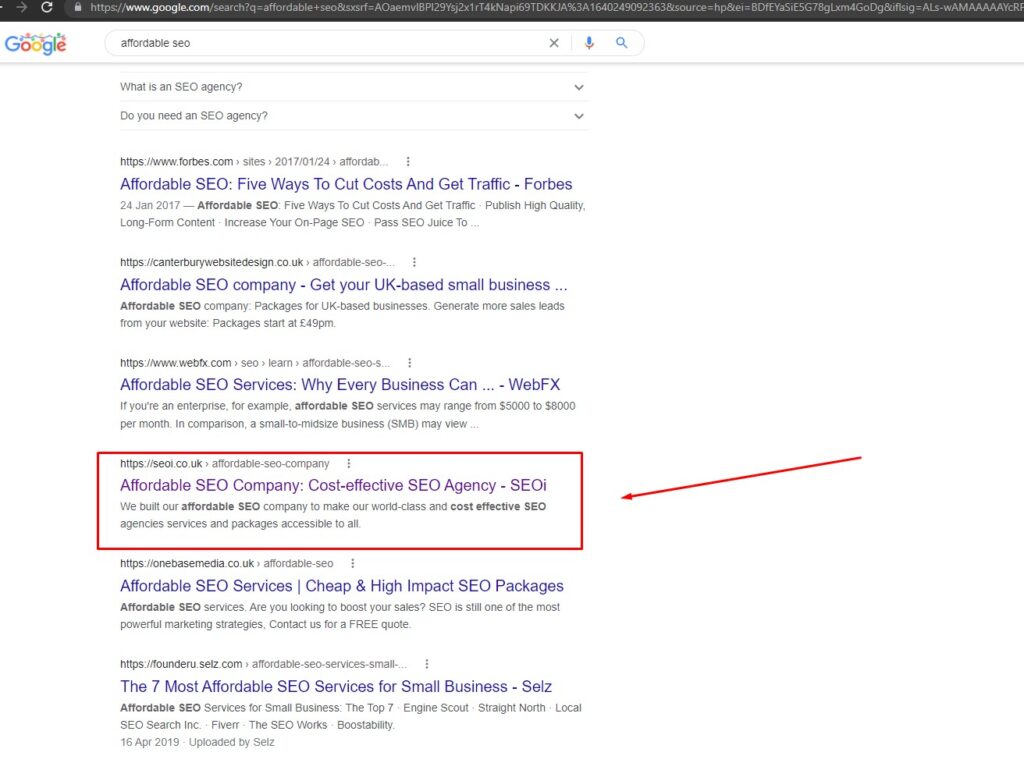
Optimise Your Meta description
A meta description or description tag again is a snippet of code added to your page.
It tells Google what you want to show up as the description under your title in the Google results. Google shows between 155–160 characters. Again use your keywords at the beginning and make sure your description reads well. This is your opportunity to persuade searchers to click on your result. To optimise it for your target audience.

Image alt tags
Add original images and save the image with a descriptive name that fits in with your content and where it’s going on the page. This also helps the search engine understand what your content is about. Also, add an alt tag to your images. This is a piece of code that adds a tag that shows up when you hover your mouse over the image.
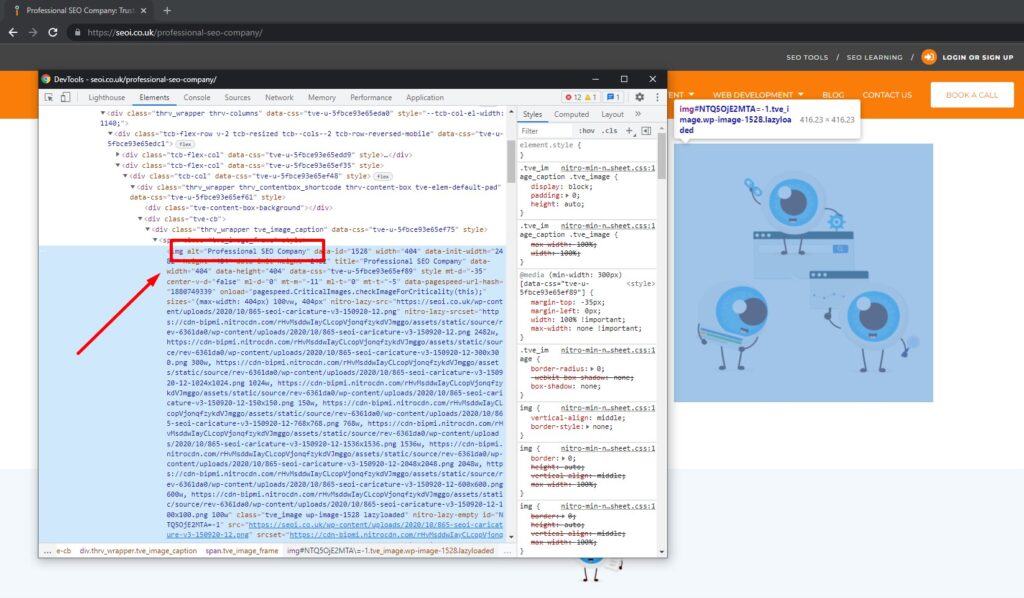
Internal links structure
Search engines want to offer a wealth of relevant information to their users on the user’s subject. It also wants it to be easily accessible. Linking to relevant content on your site. And other trusted sites that offer more relevant information the visitors may be interested in letting the search engines know your page provides a good source of information.
This also helps user experience and it can keep visitors on your site and reduce your bounce rate. If the search engines see you visitors are staying on your site. It tells them you’re a good choice for the search results.
Site structure
Your site structure also can help search engines and visitors navigate your pages and content. Your menu should be well balanced and broken down into categories. Your pages should not be any more than three clicks away is a good practice.
There are many free plugins you can use to guide you through the on-page SEO process. A great one is Yoast SEO Plugin.
2) Technical SEO and On-site SEO
On-page SEO depends on the content of the page. But anything on the website can affect the SEO rankings, including metadata, HTML code, CSS, JavaScript, images and many more. If not optimised, this can slow a site down and even block search engines from finding your pages. We call this technical SEO.
To see your site’s technical SEO health, you can get a free SEO site audit here when you sign up for a free account on SEOi.
We have separated on-page SEO and technical SEO; you can read more about technical SEO in our article on technical SEO here. Technical SEO is carried out within the code added to a site to help search engines find your site, pages, and content. It helps to speed up your site to keep the search engines happy and improve your rankings in the search engine results.
Adding all these attributes while designing a website and its pages or making these changes to a site can make a massive difference in your rankings. We see it time and time again when we carry out our on-page SEO services for our clients. This is where we start with any SEO campaign. Fixing the on-page SEO and technical SEO can improve rankings dramatically. Meaning any off-page SEO has a more significant effect and reduces campaign costs, and speeds up results.
Technical SEO methods to implement include:
Optimise your site speed
Minify your code
remove unnecessary code
compress images
Leverage Browser Caching
Image Compression and Serve Scale
Help search engines find your content
Sitemap.xml Creation
Robots.txt File Creation
Schema Markup
We have written another article breaking down the technical SEO methods and checklist. You can find this in your SEO learning hub.
If you would like help with your On-page SEO, we can help. Sign up for a free account on SEOi.co.uk. You can then carry out a free site audit to find any technical problems your site has. You can also book a call with an account manager for advice and a free SEO strategy. We offer on-page SEO packages you can purchase for a one-off cost. We also offer self-managed, affordable SEO packages you can purchase as you need or managed SEO Services.

